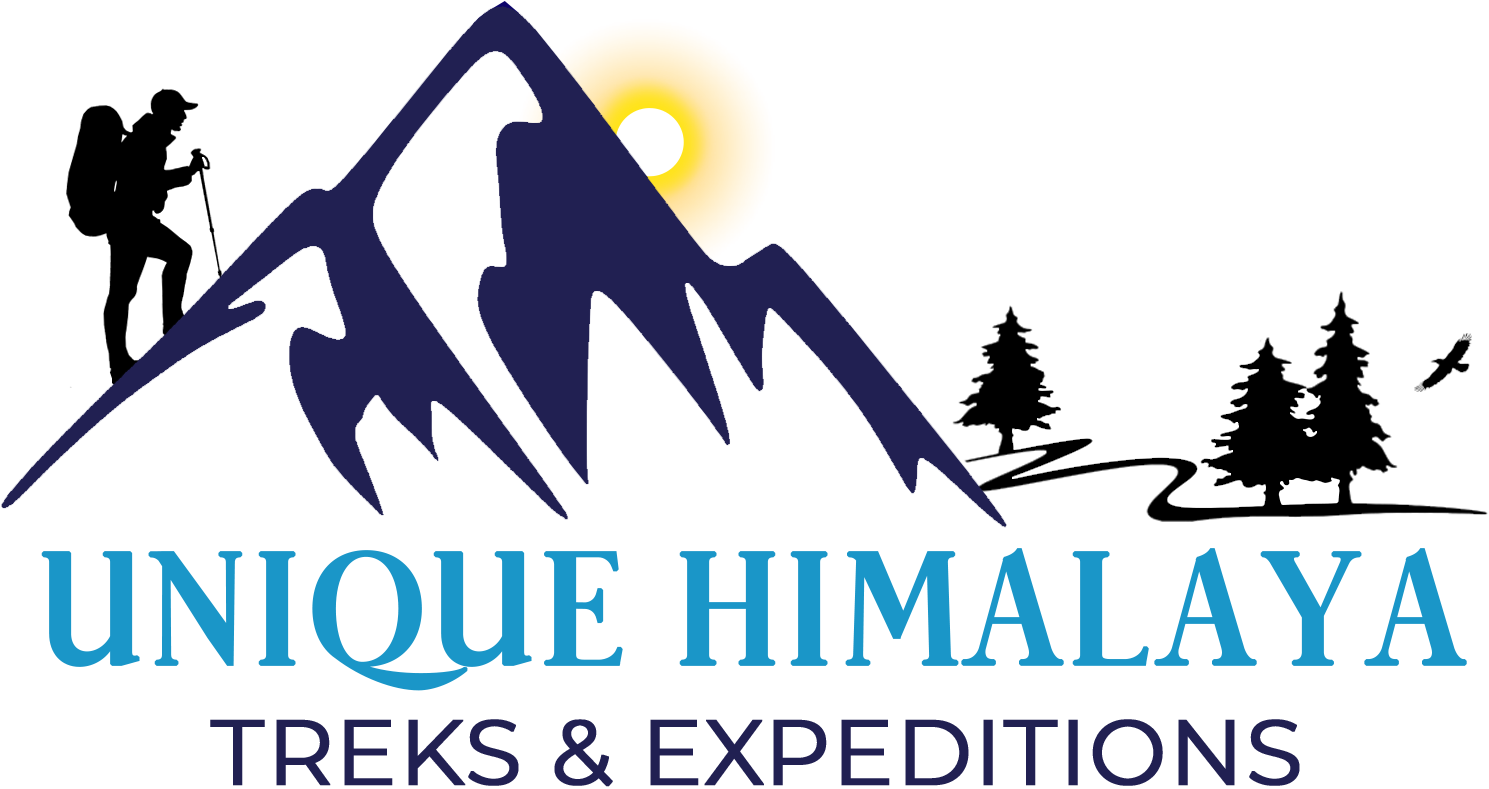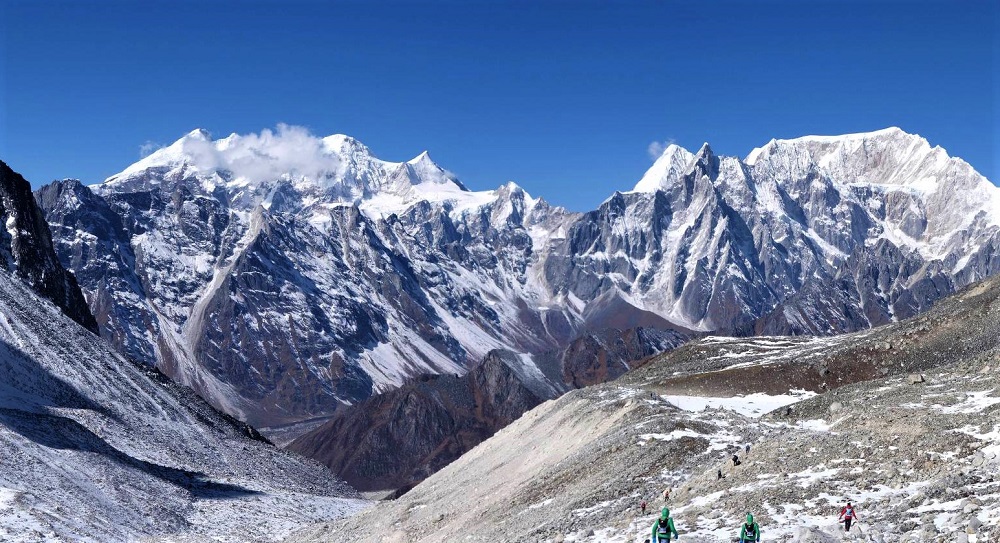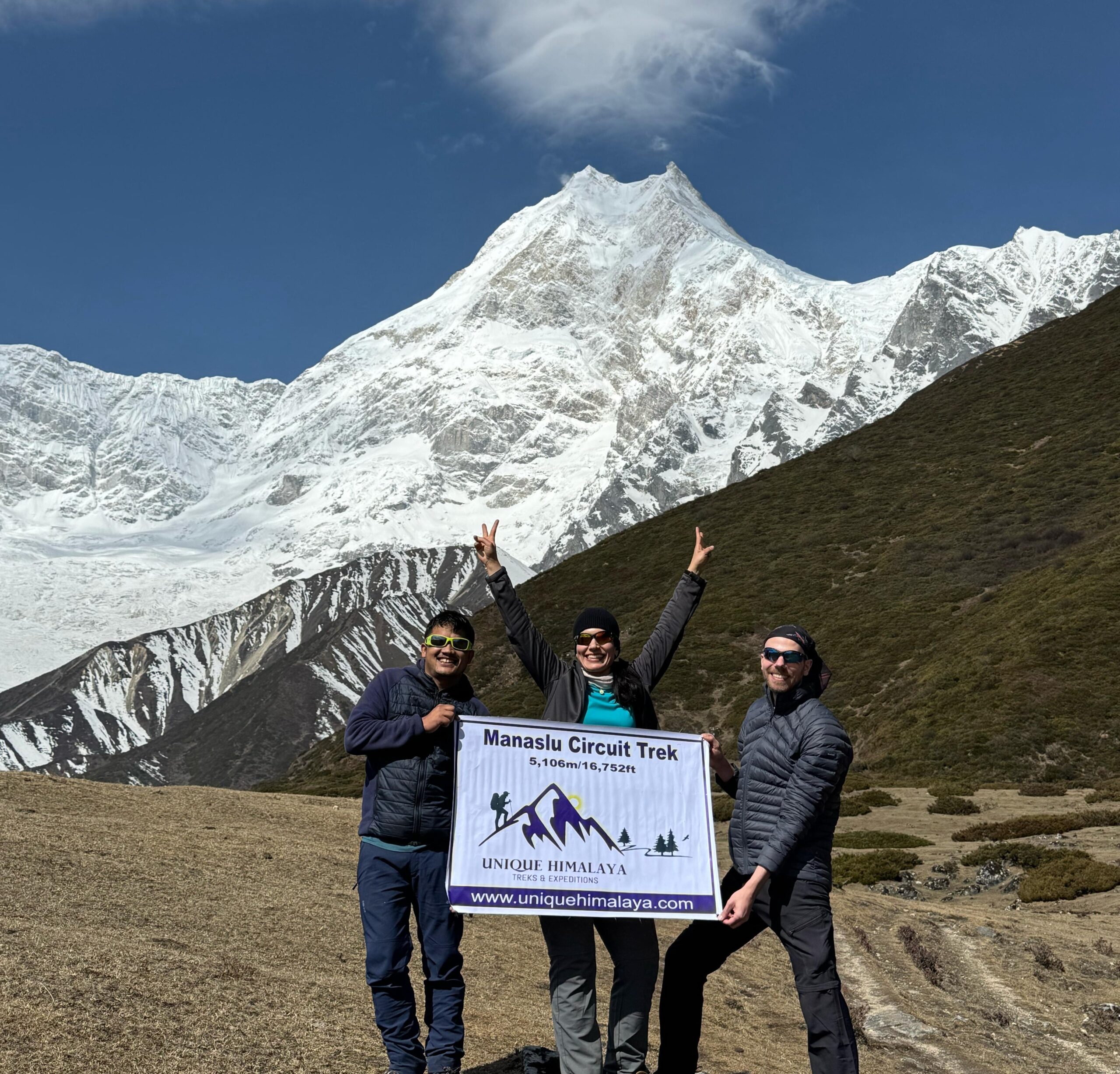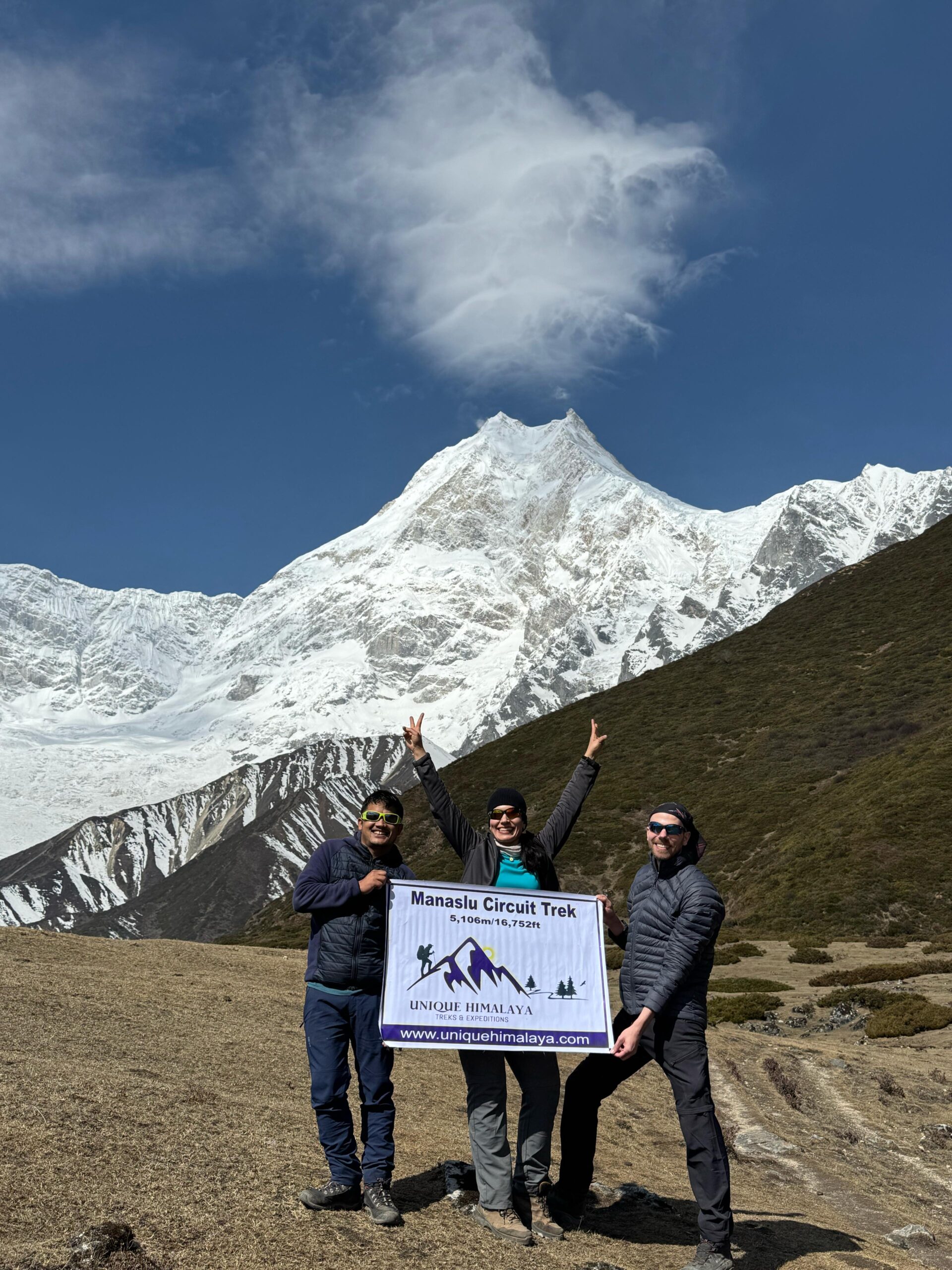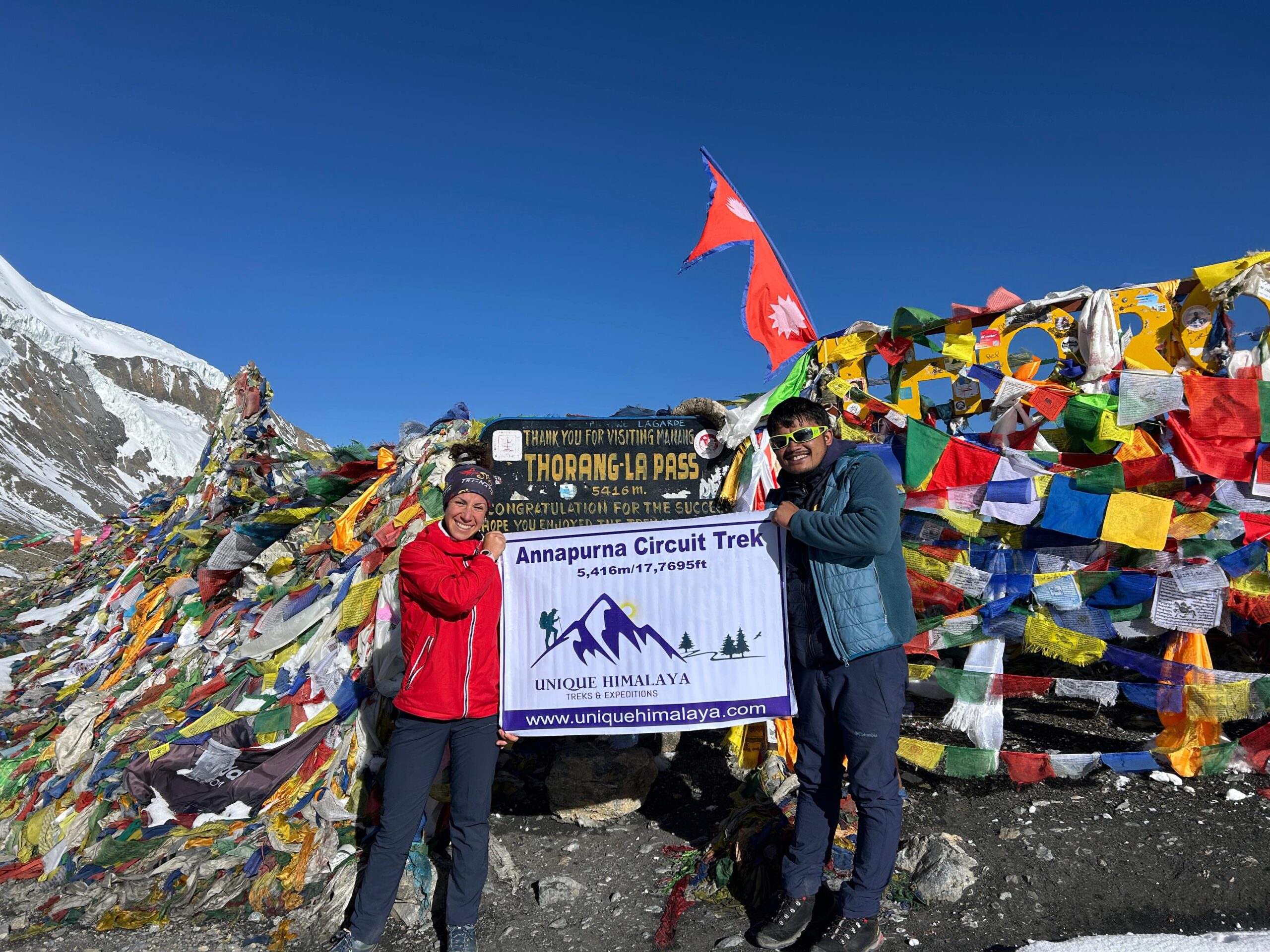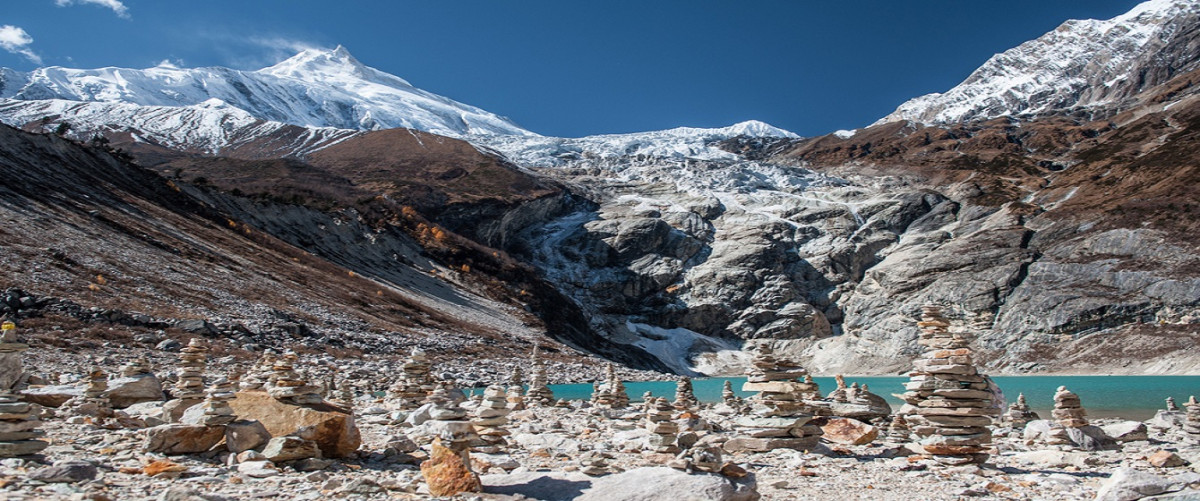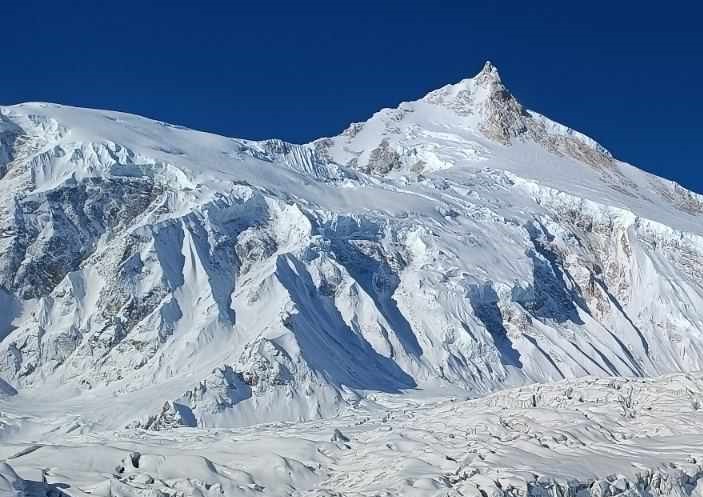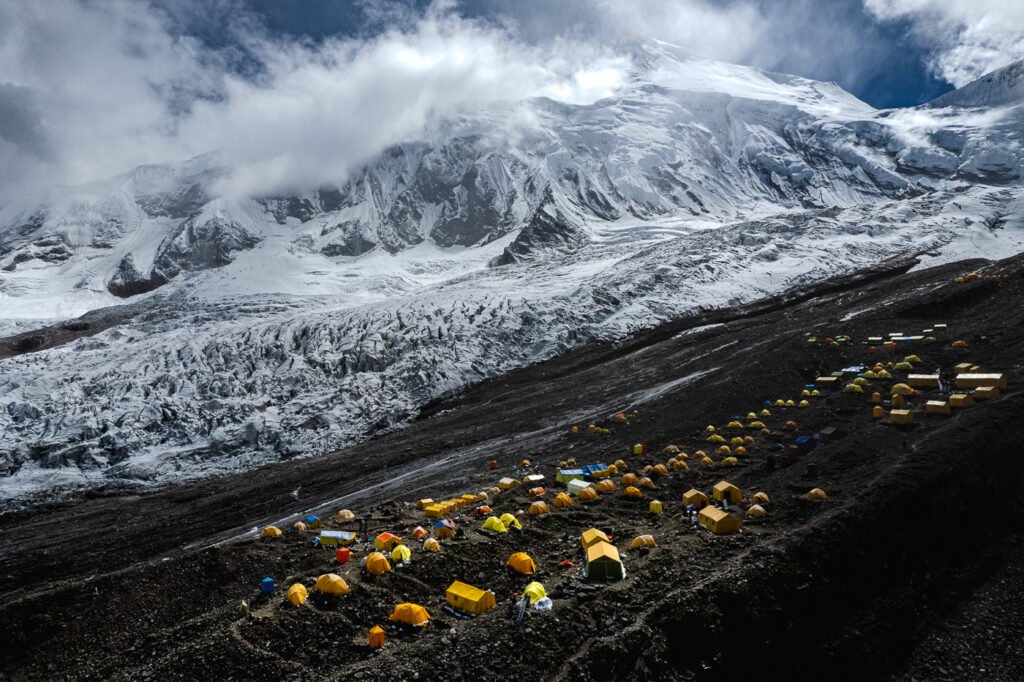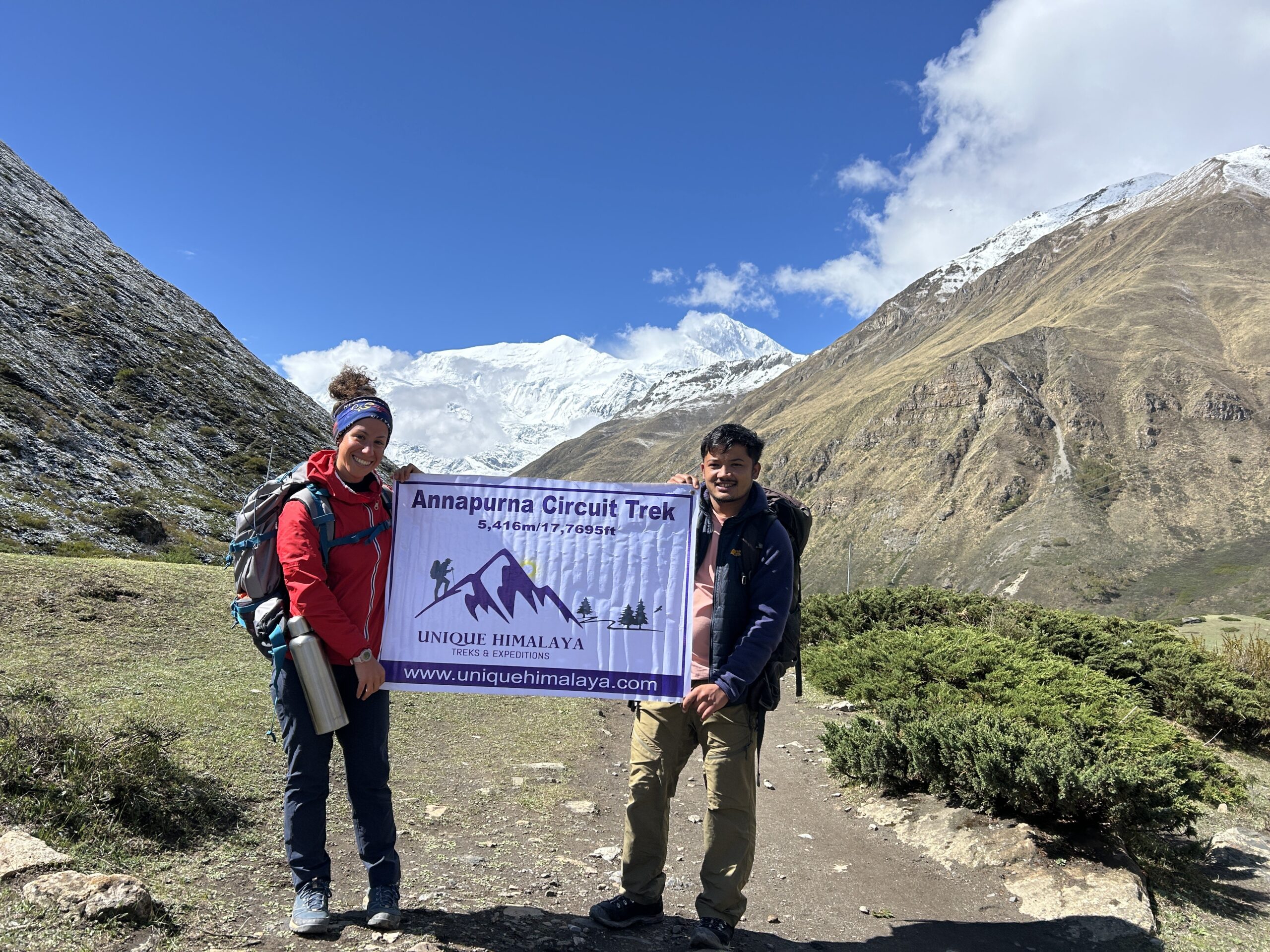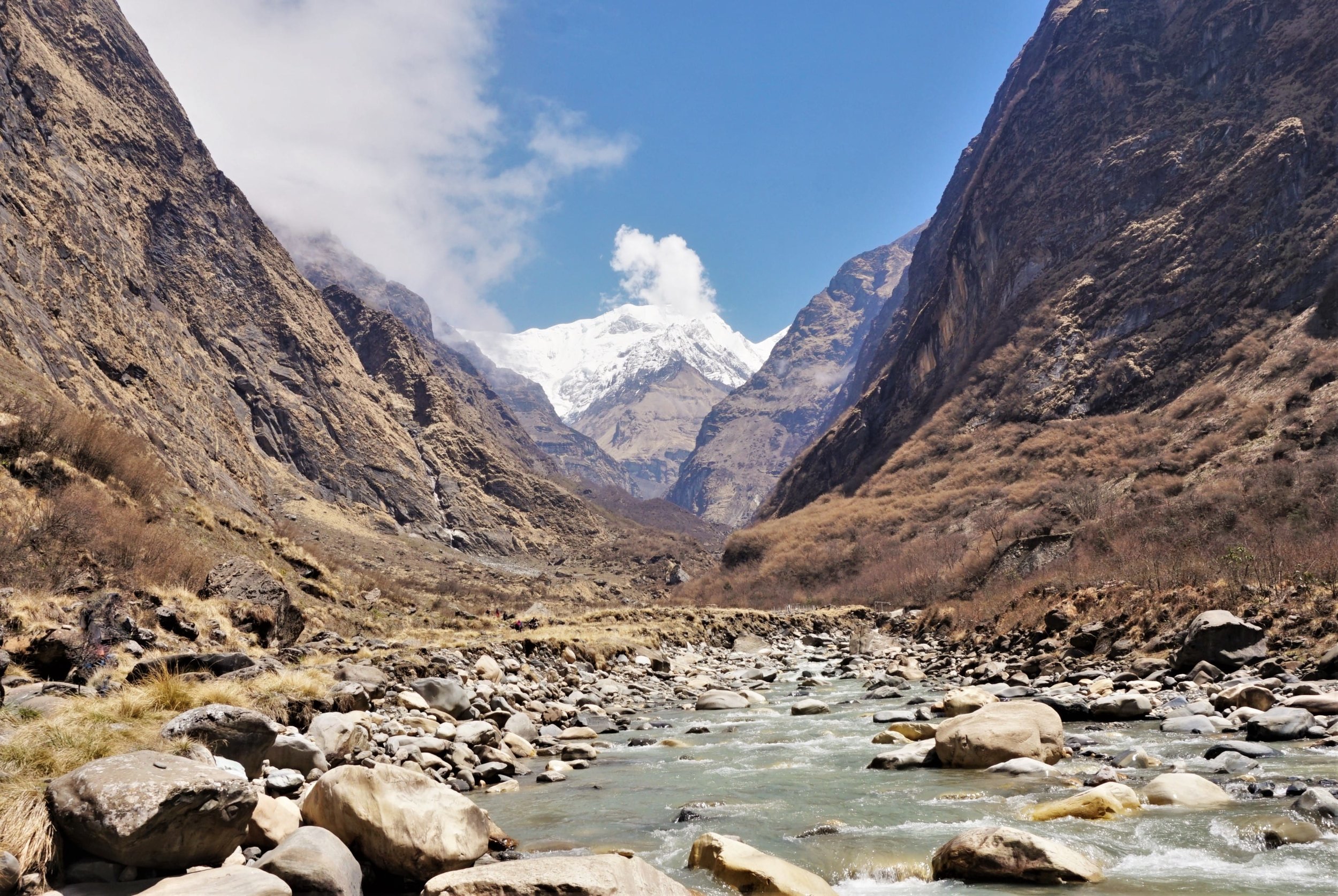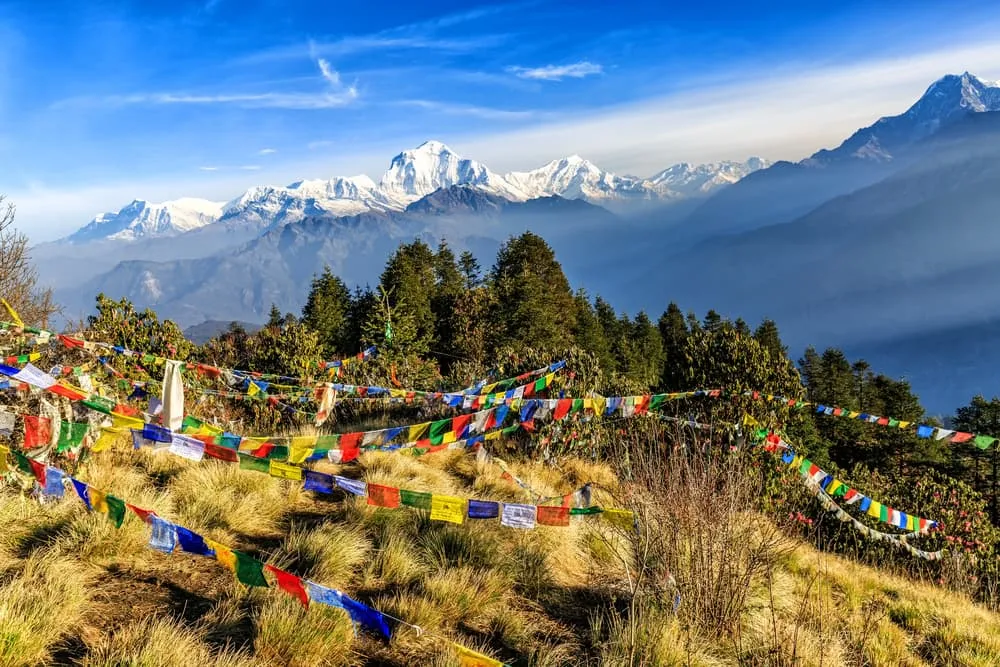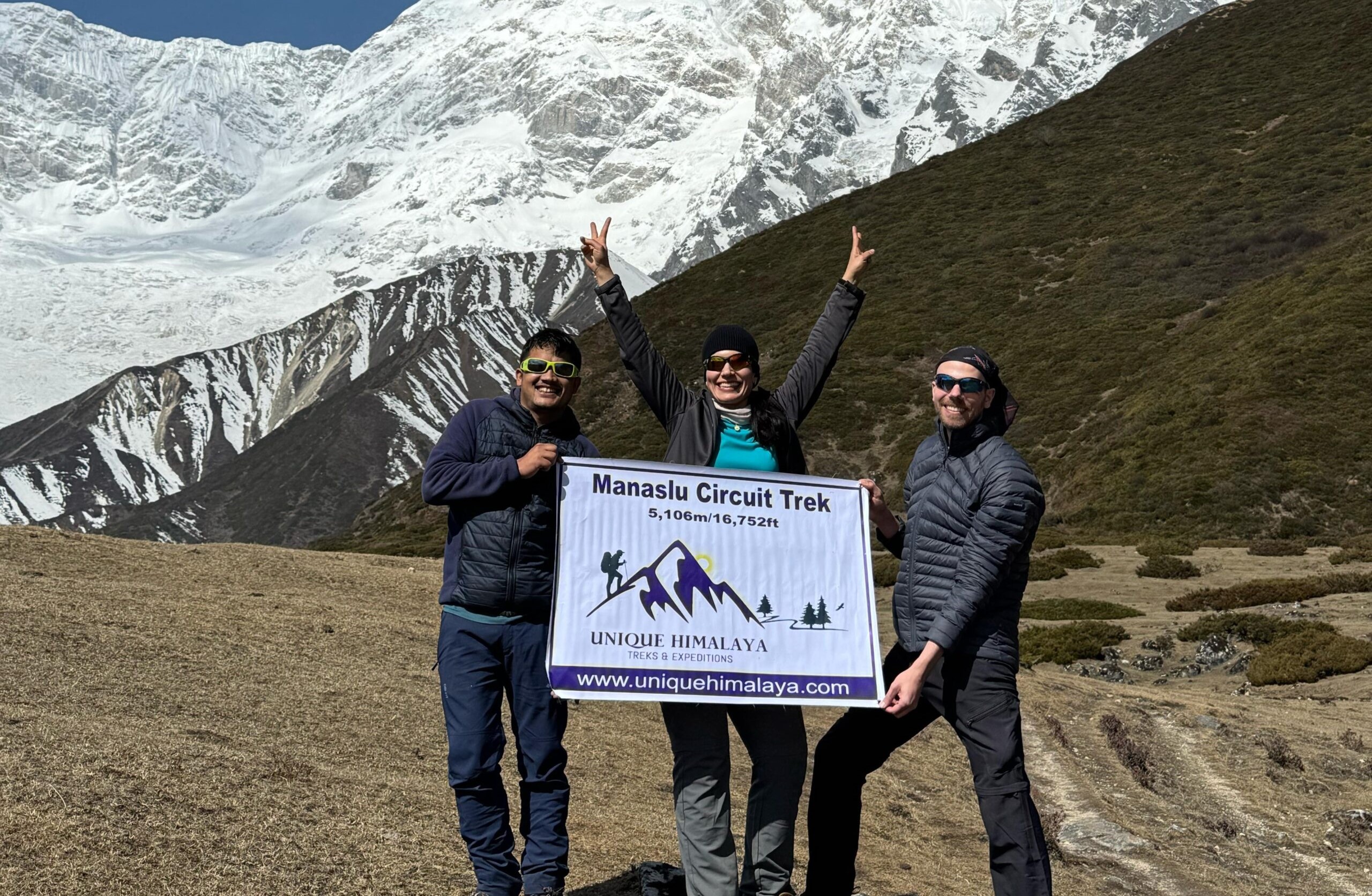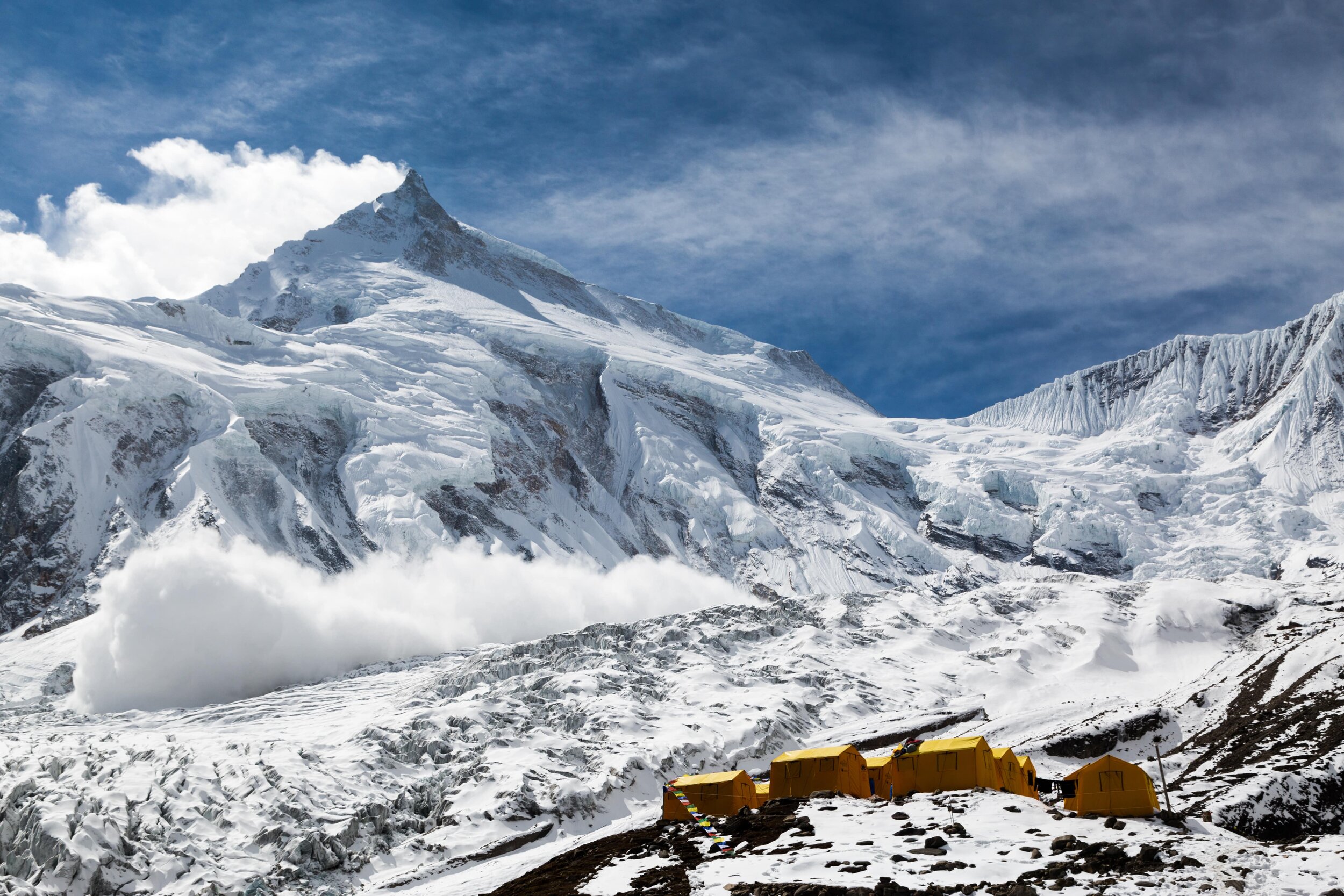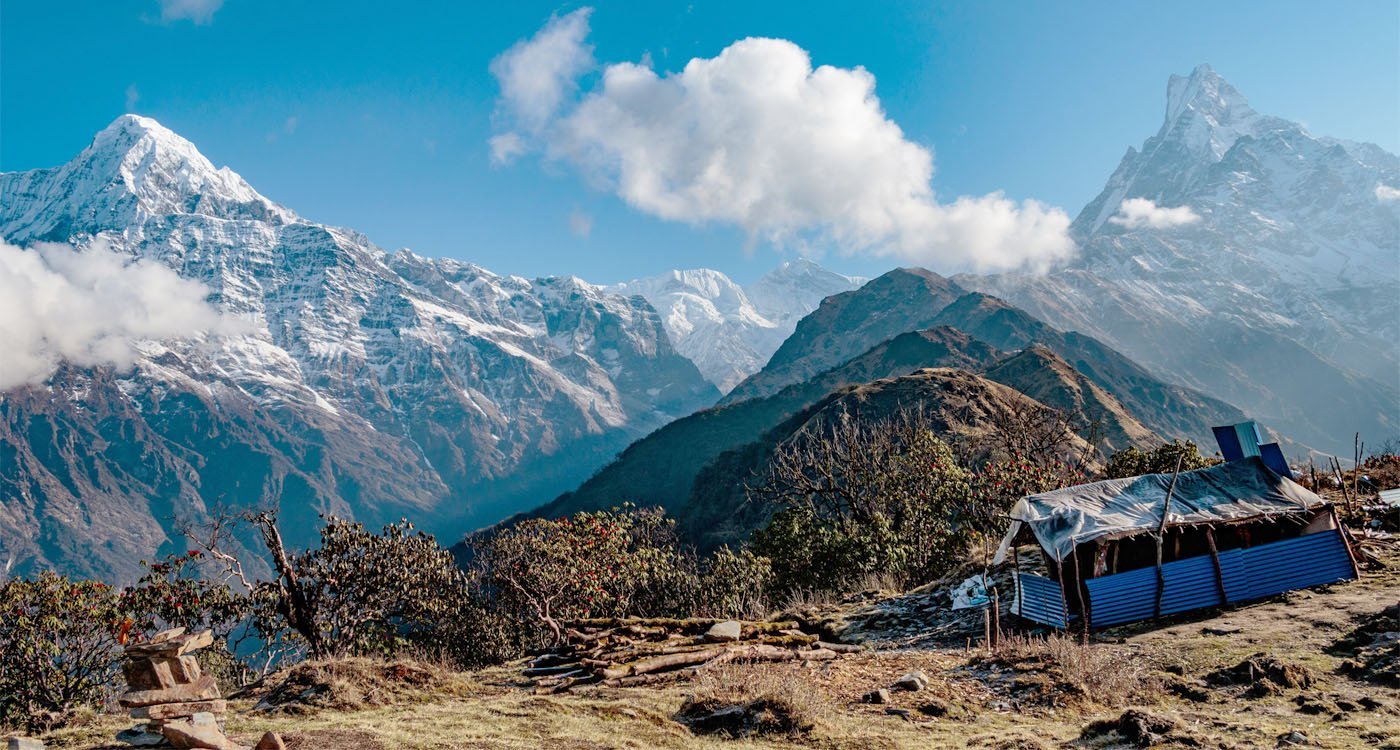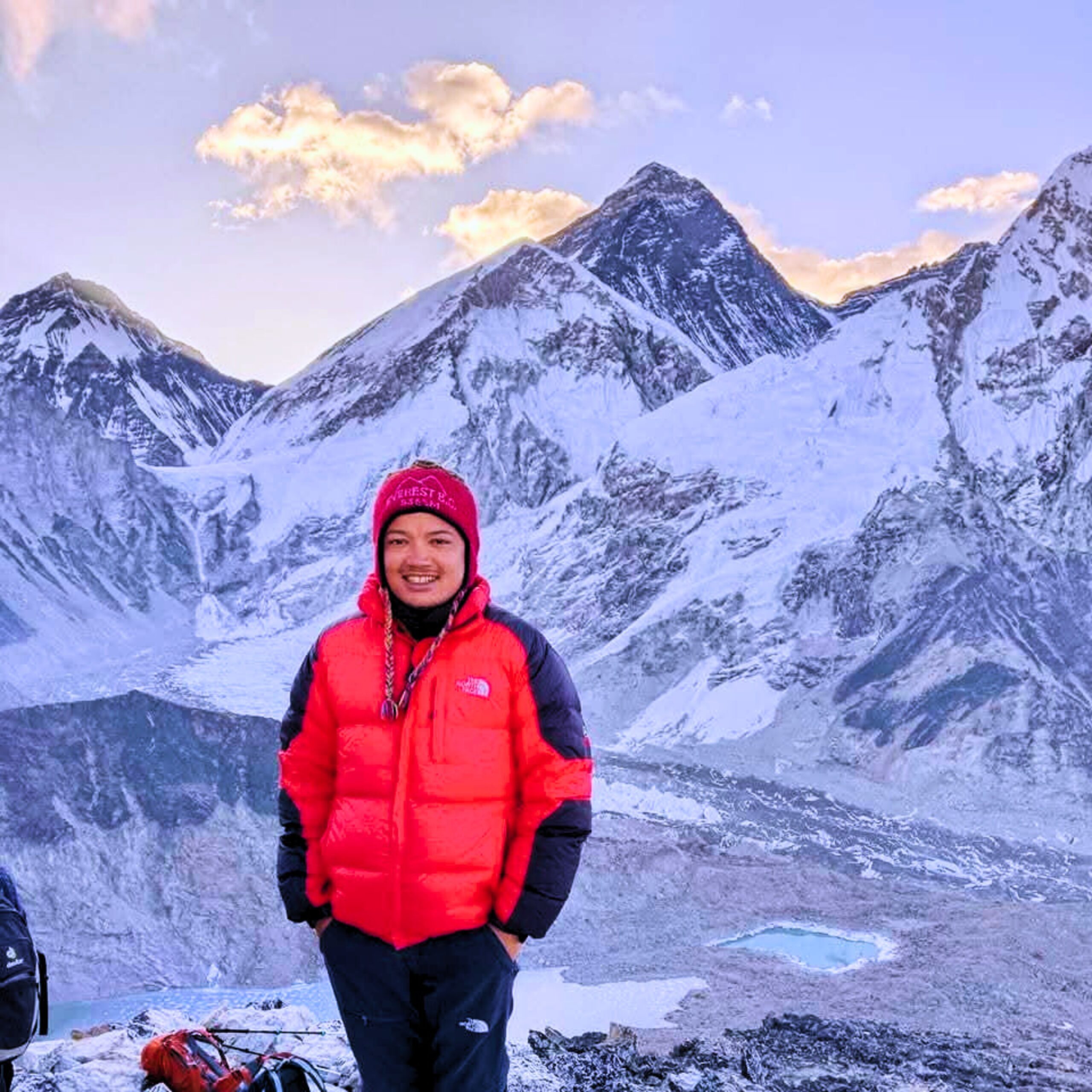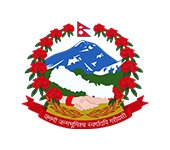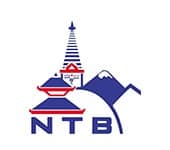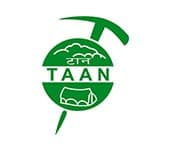Manaslu–Annapurna Circuit Trek
Destination
Annapurna-Manaslu RegionDuration
19 Days/18 NightsAccomodation
TeahousesTrek Style
Tea House TrekMax Elevation
5416 mTrek difficulty
StrenuousGroup size
2/30Best months
Spring(March to May), Autumn(September to November)Trip starts/Ends
Kathmandu-KathmanduOverview
If you are the kind of traveler who wants a trek that feels like two grand Himalayan journeys woven into a single, unforgettable story, the Manaslu–Annapurna Circuit Trek delivers exactly that. This 19-day lodge-to-lodge adventure threads together the wild, culturally intact valleys of the Manaslu Conservation Area with the iconic, high-altitude desert landscapes of the Annapurna Circuit. You begin on terraced hillsides and subtropical river canyons where Gurung and Magar communities cultivate rice and millet, then climb steadily into Tibetan-influenced highlands where mani walls, prayer flags, and chortens announce the borderland spirit of the Greater Himalaya. After you cross the snowbound Larke La at 5,160 m and descend into rhododendron and fir, the route joins the classic Annapurna Circuit and climbs again toward the legendary Thorong La (5,416 m), one of the most celebrated high passes in Nepal.
By combining two renowned routes into one continuous, well-paced itinerary, this trek multiplies the rewards—more varied scenery, more cultural immersion, and more high-mountain challenge—without rushing your acclimatization or compromising comfort. Teahouse lodging keeps the experience authentic yet practical: hot meals, warm dining rooms, and genuine hospitality await each evening. Between those warm rooms, you will negotiate airy bridges above the Budhi Gandaki, trace a path through deep gorges and mossed pine forest, and march out over wind-scoured moraines where the mountains feel near enough to touch. Manaslu (8,163 m) and Annapurna I (8,091 m) are the silent guardians of this journey, while a constellation of other giants—Himalchuli, Ngadi Chuli, Ganesh Himal, Tilicho Peak, Gangapurna, and Dhaulagiri—rise and fall along the skyline as you pass.
What truly sets this itinerary apart is its flow. The Manaslu section is raw and less commercialized: village life feels unhurried, trails are quieter, and the monasteries—some revitalized, some quietly weathering time—invite reflection. Once you crest Larke La and meet the Annapurna trail, amenities expand, bakeries start to appear, and the landscape opens into the spacious, ochre-brown valleys that define the rain shadow of Manang and Mustang. You will feel the contrast in your lungs and your legs, and you will celebrate it. Two high passes in a single expedition require respect, discipline, and a thoughtfully staged acclimatization plan. We build in an acclimatization day in Samagaon (with an optional hike to Manaslu Base Camp) and a measured approach to Thorong High Camp or Yak Kharka, so you move high with confidence.
For trekkers who have completed Nepal’s famous classics and want something more ambitious—or for first-time Himalayan visitors ready to commit to a comprehensive challenge—this itinerary brings together the best of both worlds. It is tough, yes, but it is also richly human. Shared tea with a lodge owner, a child’s laughter in a schoolyard, a soft bell on a yak caravan, the slow spin of a prayer wheel as a caretaker throws open the monastery door at sunrise—these are not just details on the way to a pass; they are the point of being here. The result is a life-affirming journey that tests your endurance, expands your cultural imagination, and rewards you with the kind of mountain perspectives that stay with you forever.
Trip Highlights
- Two-Pass Epic: Cross Larke La (5,160 m) and Thorong La (5,416 m) on a single, continuous trek.
- Wild-to-Classic Contrast: Experience the quieter, culturally rich Manaslu trail followed by the iconic Annapurna Circuit.
- Immersive Mountain Culture: Encounter Gurung, Magar, and Tibetan-influenced communities; visit monasteries, mani walls, and prayer flags.
- Constant Mountain Drama: Views of Manaslu, Himalchuli, Ngadi Chuli, Ganesh, Annapurna II–IV, Gangapurna, Tilicho, and Dhaulagiri.
- Thoughtful Acclimatization: Built-in rest day in Samagaon and gradual ascent toward Thorong La to reduce risk of AMS.
- Teahouse Comforts: Authentic lodge stays with hearty meals, warm dining rooms, and local hospitality.
- Varied Biomes: From rice terraces and subtropical forest to high alpine moraines and dry, windswept valleys.
- Flexible Side Hikes: Optional day hike to Manaslu Base Camp from Samagaon; explore Ice Lake or Praken Gompa from Manang (time- and energy-dependent).
- Finish in Style: Conclude at the sacred site of Muktinath and continue by jeep or flight to Pokhara’s lakeside.
Itinerary
Day 1
Your expedition begins the moment your plane dips above Kathmandu Valley and the mosaic of farms and temple spires comes into view. Upon arrival, our team greets you outside the terminal and transfers you to your centrally located hotel. After refreshments and a trek briefing, you can rest or stroll the narrow lanes of Thamel to pick up last-minute gear. We discuss the route, review equipment, and reconfirm permits for the Manaslu Conservation Area (MCAP), Annapurna Conservation Area (ACAP), and restricted-area entry. Overnight in Kathmandu.
Day 2
Drive to Machha Khola (900 m) – Approx. 8 hours by private jeep
We set out early, leaving the urban bustle behind for a drive that follows the Trishuli and then the Budhi Gandaki rivers into mid-hill country. The road alternates between blacktop and rougher sections, revealing steep-sided valleys, waterfalls, and villages perched above terraced fields. Machha Khola is a riverside settlement with a few lodges and a calm, rural rhythm. Tonight you get your first taste of the trail’s hospitality and a good night’s sleep before the trekking begins in earnest.
Day 3
We start gently alongside the Budhi Gandaki, crossing and re-crossing the river on suspension bridges that sway above jade-green water. The trail undulates past hamlets, waterfalls, and small shrines where locals pause briefly for a prayer. The gorge narrows, rock walls steepen, and the sound of the river becomes constant. Jagat, a compact stone-paved village, marks an administrative entry point for the restricted zone. The village square, lined with lodges and shops, is an atmospheric place to unwind at day’s end.
Day 4
The trail continues through subtropical forest and sculpted rock formations. You pass mani walls and painted boulders that hint at the Tibetan cultural sphere ahead. Bridges carry us from one bank to another as we negotiate landslide corridors and narrow ledges above the river. Deng sits on a shelf with views toward higher, darker forest. The air is cooler; the menus begin to feature more barley, buckwheat, and Tibetan-style bread alongside dal bhat.
Day 5
This is one of the trek’s transitional days. Forest thickens and the villages adopt a more distinctly Tibetan character—stone houses with wooden windows, prayer flags, and sturdy livestock pens. The gradient steepens in places, rewarded by occasional clearings with views to snow-streaked ridges. Arriving in Namrung, you feel the elevation: the light is whiter; the temperature dips quickly at dusk. Namrung’s viewpoint is perfect for sunset photography if weather allows.
Day 6
Mornings are crisp now. Trails trace through mixed hemlock and rhododendron, then open fields walled by stacked stone. Khukuri-shaped peaks peek between larch boughs. Lho is a beautiful village dominated by a hilltop monastery and a magnificent backdrop of Manaslu’s eastern faces. In the late afternoon, young monks often practice at the monastery courtyard; a respectful visit (no photos inside without permission) is a moving cultural highlight. Clear nights offer brilliant stargazing.
Day 7
We ascend gradually to Shyala, a village with panoramic views of Himalchuli, Ngadi Chuli, and Manaslu. From here the valley widens and the moraine textures grow more pronounced. Samagaon appears with its iconic cluster of stone houses, spinach and potato fields, and an ancient gompa set against big-mountain scenery. Lodges here are among the best on the Manaslu circuit, with warm dining rooms and hearty menus. Overnight in Samagaon.
Day 8
A full rest and acclimatization day is essential before pushing higher. After a slow breakfast, you can explore the village, visit the monastery, and practice the clockwise kora around mani walls like locals do. For those with energy and good acclimatization signs, an optional guided hike climbs toward Manaslu Base Camp, offering immense views and helping your body adapt. Hydration, light stretching, and an early night are encouraged.
Day 9
Today’s walk is short but strategic for acclimatization. The trail rises across yak pastures and skirts glacial moraines. Samdo sits near the old Tibetan trading route and retains an authentic highland feel—stone homes clustered for shelter from the wind, yaks grazing, and the ever-present prayer flags. Spare your lungs by walking slowly, and enjoy the stark beauty of the high plateau.
Day 10
We move deliberately to the high camp area beneath Larke La. The landscape is raw—boulder fields, braided streams, and wind-etched slopes. Lodging is basic here due to altitude and exposure, but the warmth of the kitchen and camaraderie of fellow trekkers make up for it. Early dinner and an early bedtime set us up for a pre-dawn pass crossing.
Day 11
Before sunrise we set off, headlamps tracing a quiet zigzag up the cold slope. Patience and steady breathing carry us to prayer flags marking Larke La. The panorama at the top is profound—peaks roll north to Tibet and south toward the middle hills. We descend carefully on sometimes icy ground to reach the alpine bowl of Bimthang, ringed by snowy ridges. The lodge meals here taste especially good after a big day—try the vegetable thukpa or a celebratory slice of apple pie if available.
Day 12
The descent continues through fragrant pine, fir, and rhododendron forest, with milky glacial streams shouldering the path. As elevation drops, lungs relax and stride lengthens. At Dharapani we officially intersect the Annapurna Circuit, where lodges are more numerous and the trail community expands. Overnight in a comfortable teahouse with hot showers available.
Day 13
A scenic drive (road and trail conditions permitting) shortens the approach, after which we resume trekking toward Pisang. The Marsyangdi Valley narrows between dramatic rock faces, including the “Paungda Danda” rock slab near Pisang that looks like a giant stone wave. Choose lower or upper Pisang depending on energy and preference; Upper Pisang rewards with better views but adds a steeper climb to lodge at day’s end.
Day 14
We traverse juniper slopes and buckwheat fields with sweeping views of Annapurna II, III, and IV, as well as Tilicho and Gangapurna. The air is arid here, sunlight sharp and clean. Manang is a bustling high-valley hub with bakeries, gear shops, and a health post that offers altitude consultations. Options for side hikes abound if you have spare time and energy—Praken Gompa viewpoint or the Gangapurna Lake circuit are favorites.
Day 15
We climb slowly out of Manang toward the yak pastures. The path contours above the valley and crosses wooden bridges over side streams. Yak Kharka is a good, conservative stop for extra acclimatization; those feeling robust may push to Thorong Phedi (High Camp is another 45–60 minutes above). The key is to sleep lower if you went very high during the day—listen to your body and your guide.
Day 16
Another alpine start leads to one of the great passes of the Himalaya. The slope is steady but long, and wind can be a factor. At the top, prayer flags snap in the breeze and the views spill toward Mustang and Dhaulagiri. The descent to Muktinath is long on tired legs but constantly inspiring. After visiting the sacred site—revered by both Hindus and Buddhists—we continue by jeep along the Kali Gandaki corridor to Jomsom. Overnight in Jomsom.
Day 17
Weather permitting, a short morning flight carries us to Pokhara; alternatively, we drive along the valley. In Pokhara, lakeside cafés, gentle boat rides, and soft hotel beds make a fine contrast to the high, dry land you have crossed. Celebrate the journey and enjoy a relaxed evening on the lakeshore.
Day 18
After breakfast, we board a comfortable tourist bus for the scenic return to Kathmandu (or opt for a flight, subject to availability). Back in the capital, last-minute souvenir shopping and a farewell dinner close the arc of the adventure.
Day 19
We transfer you to the international airport in time for your flight. As the plane climbs above the valley, you will see again, in miniature, the terrain you traversed—the terraces, the ridges, the white summits—and you’ll carry the story home.
What's Included
- Airport transfers in Kathmandu (arrival and departure).
- Private jeep Kathmandu → Machha Khola; ground transport during the trek as per itinerary; Jomsom → Pokhara flight/jeep; Pokhara → Kathmandu tourist bus.
- Twin-sharing accommodation in standard teahouses/lodges during the trek.
- Hotel accommodation in Kathmandu and Pokhara (twin-share, breakfast included) as per the final plan.
- Three meals a day during trekking (breakfast, lunch, dinner)
- Licensed, English-speaking trekking guide with high-altitude experience; assistant guide(s) where group size requires.
- Porter service (1 porter per 2 trekkers; 20–22 kg combined limit).
- Manaslu Restricted Area Permit (seasonal rules apply), MCAP and ACAP permits, TIMS as applicable.
- Down jacket and sleeping bag on (to be returned after trek), trekking map.
- First-aid kit with pulse oximeter and standard AMS protocol guidance.
- Government taxes and company service charge.
What's Excluded
- International airfare, Nepal visa fees, and personal travel insurance.
- Lunch and dinner in Kathmandu/Pokhara (unless otherwise specified).
- Hot showers, battery charging, and Wi‑Fi where lodges charge extra.
- Alcoholic drinks, bottled beverages, and snacks beyond standard meals.
- Personal trekking gear and clothing, including footwear.
- Tips for guide, porter(s), and driver(s) (customary but at your discretion).
- Emergency evacuation costs, medical treatments, or extra nights due to weather, illness, or itinerary changes.
- Optional activities, side trips, and any services not explicitly listed in “Cost Includes.”
Gallery
Essential Info
Best Time To Trek
The Manaslu–Annapurna combination rewards trekkers across two main seasons:
- Spring (March–May): Rhododendron forests light up the Manaslu mid-elevations; stable mornings, occasional afternoon clouds. High passes hold residual snow in March; April–May are kinder for Larke/Thorong. Wildlife is active; photography is superb with strong contrasts.
- Autumn (September–November): Post-monsoon clarity brings exceptional visibility and cool nights. Trails are livelier, lodges stocked, and the high passes generally present firm, grippy conditions. Late October into early November is prime for deep-blue skies.
- Shoulder Periods: Early December can still be excellent if storms are absent, but cold is real and days shorter; late February is a cautious re-entry with lingering snow. Monsoon (June–August) is lush and quiet on lower Manaslu sections but wet, leechy, and not ideal for the high passes.
Elevation & Distance Overview (Approximate)
- Kathmandu: 1,300 m
- Machha Khola: 900 m – Drive day
- Jagat: 1,340 m – 22–24 km from Machha Khola (8–9 hrs, cumulative)
- Deng: 1,860 m – 20–22 km (7–8 hrs)
- Namrung: 2,630 m – 18–20 km (6–7 hrs)
- Lho: 3,180 m – 10–12 km (4–5 hrs)
- Samagaon: 3,530 m – 8–10 km (4–5 hrs)
- Samdo: 3,860 m – 8–10 km (3–4 hrs)
- Dharamsala: 4,460 m – 7–8 km (3–4 hrs)
- Larke La (5,160 m) → Bimthang (3,590 m) – 18–20 km (8–10 hrs including pass)
- Dharapani: 1,963 m – 22–24 km (7–8 hrs, mostly descent)
- Chame → Pisang: 3,200 m – mixed drive/trek day, 12–15 km trekking
- Manang: 3,540 m – 16–18 km (6–7 hrs via Upper Pisang route)
- Yak Kharka/Thorong Phedi: 4,050–4,540 m – 9–12 km (4–6 hrs)
- Thorong La (5,416 m) → Muktinath/Jomsom – 20–24 km (8–10 hrs to Muktinath; jeep to Jomsom)
- Pokhara: 822 m – flight/drive
Distances vary with route choices (Upper/Lower Pisang) and lodge locations.
Trek Difficulty & Altitude Sickness
This is a challenging high-altitude trek with two major passes above 5,000 m. Daily hiking hours typically range from 5–8 hours, with two long pass days. The main challenge is altitude management rather than technical terrain; in dry conditions, trails are non-technical but include steep ascents/descents, occasional landslide traverses, and loose moraine.
- Fitness: Strong cardiovascular base, leg endurance, and the ability to walk multiple consecutive days carrying a light daypack are essential.
- Acclimatization: Our itinerary staggers ascent and builds in a full acclimatization day at Samagaon. “Climb high, sleep low” side hikes are recommended when available.
- AMS Awareness: Mild symptoms (headache, poor sleep, reduced appetite) are common and often resolve with rest, hydration, and conservative pacing. Severe symptoms (persistent headache, vomiting, ataxia, shortness of breath at rest) require immediate descent and medical evaluation. Guides carry a pulse oximeter and understand evacuation protocols.
- Weather/Season: Wind chill on passes is significant; storms can add snow/ice that demand microspikes. Shoulder seasons require extra caution with daylight and cold management.
Accommodation, Food & Drink
Teahouses along this combined route range from simple family-run homes to larger, purpose-built lodges. Rooms are typically twin-share with foam mattresses and warm blankets; bring a quality sleeping bag (–10°C comfort recommended for shoulder seasons). Toilets vary from shared Western-style to squat. Dining rooms are communal and heated in the evening (often by yak-dung or gas heaters).
- Meals: Expect dal bhat, vegetable curries, fried rice/noodles, Tibetan bread, momos, and soups at most elevations. On the Annapurna side, bakeries and coffee shops appear in Manang and beyond. Vegetarian options are plentiful; meat availability decreases with altitude due to transport and storage constraints.
- Water: Purified/boiled water is available for purchase. Bring a reusable bottle plus purification tablets or a filter to reduce plastic waste.
- Hygiene: Handwashing and sanitizer use are important. At higher lodges, hot showers may be limited and are often available at extra charge.
Preparation & Fitness
Begin targeted training 8–12 weeks before departure if possible:
- Aerobic Base: 3–4 sessions/week of brisk hiking, running, cycling, or rowing (45–90 minutes).
- Strength: 2 sessions/week focusing on legs (squats, lunges, step-ups), core, and posterior chain.
- Hike Specific: Weekend hikes with a 6–8 kg daypack; include elevation gain where possible.
- Altitude Strategy: Arrive well-rested and well-hydrated; avoid alcohol before the high days; follow the guide’s pace; adopt “pressure breathing” on steeper sections.
- Gear Familiarity: Break-in boots, test layers and pack system, and dial in blister prevention (liner socks, tape, lubricants).
Gadget Charging & Internet
Power is available at most lodges for a fee above Samagaon and on the Annapurna side. Bring a high-capacity power bank (10,000–20,000 mAh), spare camera batteries, and efficient charging cables. Solar can be useful but depends on weather and downtime. Wi‑Fi is available in many lodges on the Annapurna trail (often paid); connectivity on the Manaslu side is spottier and slower. Local SIM data (NTC/Ncell) works intermittently—expect 2G/3G patches rather than continuous service.
Transportation
- Inbound/Outbound: Airport pick-up and drop-off in Kathmandu.
- Approach: Private jeep from Kathmandu to Machha Khola to start the trek.
- Mid-Route: Overland drive to Chame on Day 13 (road conditions permitting); jeep from Muktinath to Jomsom on Day 16.
- Exit: Short flight or jeep from Jomsom to Pokhara on Day 17; tourist bus (or optional flight) from Pokhara to Kathmandu on Day 18.
Road conditions and flight schedules are weather-dependent; flexibility is part of Himalayan travel.
Travel Insurance
Comprehensive travel insurance covering high-altitude trekking (up to 5,500–6,000 m), medical treatment, and emergency evacuation is mandatory. Check that helicopter evacuation is explicitly included and that your policy covers trip interruption/cancellation. Carry digital and paper copies of your policy and emergency contact numbers. If you rely on a credit-card policy, verify altitude and evacuation clauses in writing before travel.
Extra Expenses (Guide Estimates)
- Meals in Kathmandu/Pokhara (if not included): USD 10–20 per meal.
- Showers, charging, and Wi‑Fi in lodges above 3,500 m: USD 2–6 per service.
- Bottled or boiled water: USD 1–4 per liter (rises with altitude).
- Personal snacks and bakery treats: USD 1–6 per item.
- Hot drinks (tea, coffee, hot lemon): USD 1–4 per cup (higher at altitude).
- Tips: Guide USD 6–10 per trekker per day; Porter USD 4–6 per trekker per day (or a pooled envelope at the end).
- Souvenirs/Donations: Optional monastery donations and small purchases in villages.
- Unplanned stops/extra nights due to weather or health: budget a contingency buffer.
Why Choose This Trek / Final Notes
The Manaslu–Annapurna Circuit Trek is a rare chance to experience two of Nepal’s finest long-distance trails in one continuous narrative—quiet valleys into rugged highlands, then legendary passes into sunlit rain-shadow country. It balances wilderness with culture, ambition with safety, and authenticity with comfort. With a careful acclimatization plan, experienced leadership, and realistic expectations, you can cross both Larke La and Thorong La with confidence. Come prepared, trek mindfully, and let the mountains do their timeless work.


